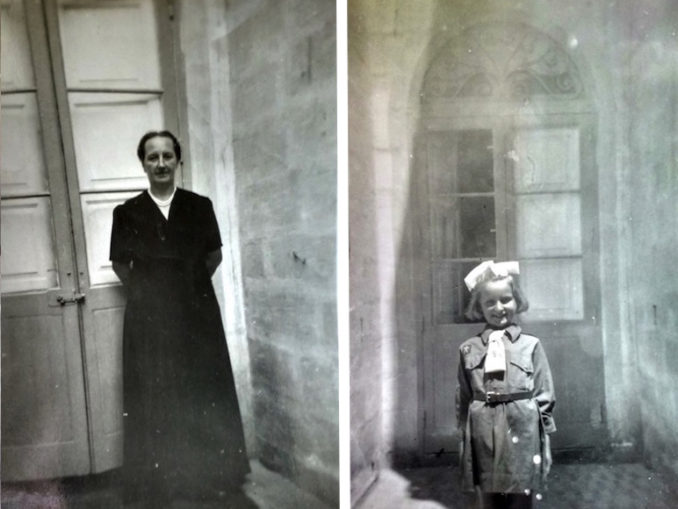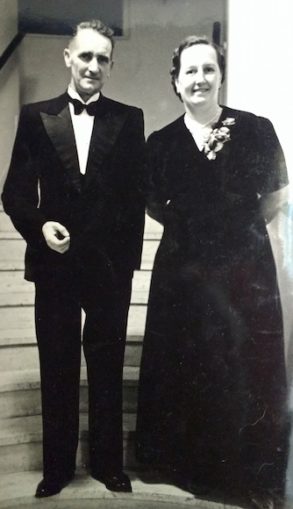
© Always Worth Saying 2022, Going Postal
At the end of the Second War, my father’s cousin Anne and her mother travelled to Malta to join her father Rob who was a Royal Navy foreman in Malta’s Grand Harbour dockyards. They lodged in a pleasant property in Amery Street, Sliema, on the other side of Marsamxett harbour from Valetta and took lots of photographs! As well as handwritten with ‘Carnival, 1947’ or ‘HMHS Maine’, the back of some of the photos are stamped ‘Printed by Vella’s studios, 56 Prince of Wales Rd, Sliema’.
It is now known as Manwel Dimech Street after the Maltese socialist, philosopher, journalist, writer, poet, social reformer, petty thief and all-around trouble maker. Not quite a Prince Charles or Henry Tudor. In the modern-day, the thoroughfare remains a district of small owner-occupied shops with outlets topped apartments fronted by typical Maltese covered wooden balconies, known locally as ‘balkone’.

Traditionelle Maltesische Balkone in Sliema,
HH58 – Licence CC BY-SA 4.0
Number 56 is still a shop and belongs to Mr Micallef the watch marker. With a slanted display window leading to a front door, caught by Street View behind a siesta iron grill, it is still possible for the mind’s eye to imagine shelves covered in cameras and photos as if 75 years ago. On the opposite side of the narrow street, sits Mr Fixit’s Lampshade Centre and a shop marked ‘Textiles and Hosiery’. Next door, with a distinctive red and white halved shield and the letters PN, is the Maltese Nationalist Party, Partit Nazzjonalista.
There at the same time as Rob, Lil and Anne, were Lieutenant Philip Mountbatten and Princess Elizabeth. Philip, not yet a prince, served in the Navy in Malta on HMS Chequers. Between 1946 (their marriage was in 1947) and ascending to the thrown in 1952, Princess Elizabeth made regular and long visits to the island in between her other duties. Between 1949 and 1951, the young couple lived at Villa Guardamangia beside the government quarter and just outside Valetta city walls.
Thought to have been built around the middle of the 18th century, the villa had been home to many notable Maltese families before being leased to Louis Mountbatten (the Duke of Edinburgh’ss uncle) in 1929 with the villa being passed to the royal couple in 1949.

Villa Guardamangia in Pietà,
Continentaleurope – Licence CC BY-SA 3.0
As recently as 2019, a dilapidated Villa Guardamangia was up for sale with an eye-watering £5.3 million price tag. The 1,560sqm palazzo-style mansion enjoys six, bedrooms three bathrooms, a ‘grand sala mobile’ living room and guests’ and servants’ quarters.
Princess Elizabeth looked back on this as one of her happiest times when she could live a normal life as a naval officer’s wife and volunteer at the Soldiers, Sailors and Airman Families Association (SSAFA). The Queen and the Duke returned to Malta to celebrate their 60th wedding anniversary in 2007. Six decades earlier, living only a mile and a quarter from Sliema, newspaper reports told of Her Majesty going to the cinema there and swimming off Sliema beech.
Did they meet Rob, Anne and Lil? My father’s cousin and her parents definitely went swimming but, although there are beach photos in our Nostalgia Album, the seafront at Sliema has changed, or at least the landmarks behind it have, with rows of two-story Victorian terraces with picturesque slatted shutters and bay windows being replaced by blocks of flats. Elsewhere along the Maltese coast there has been less development. Helpful landmarks remain, as do captions on the reverse of the photos.

© Always Worth Saying 2022, Going Postal

© Always Worth Saying 2022, Going Postal
The topmost of the above two photographs has ‘Ghajn Tuffieha’ written on the back. Although the bottom photo is uncaptioned it shows an important Ghajn Tuffieha landmark at the top of the hill. Directly opposite Valetta and Sliema, on the western coast of the island, are two bays. The more popular, Golden Bay, sits just to the north on the other side of the clay headland in the above background. From the main road, two hundred steps run down to the beach. Out of view on the left-hand side is one of the island’s defensive coastal towers built in 1637.
During the First War, with casualties arriving from the Middle East, Balkans and Turkey, Malta was known as ‘the nurse of the Mediterranean’. A 1919 Scotsman article recalls Ghajn Tuffieha’s role.
“Thirdly, there were the Convalescent Camps. Largest of these was Ghajn Tuffieha which really comprised four within the one area. Here one might find three kinds of patients – the wounded, the sick, and ‘the homesick; and I am not sure but that the greatest of these was the last.”
Tellingly in inverted commas, we must assume in today’s terms ‘homesick’ to be a euphemism for shell sock or traumatic stress disorder. After informing us part of the rehabilitation process is keeping the men busy after the surgeons have done their work The Scotsman goes on to describe another facility there, a YMCA hut capable of seating 500 men with a stage at one end and a refreshment counter at the other.
Ghajn Tuffieha first became a military area at the very beginning start of the 20th Century with, in 1902, Royal Marines stationed there under canvas.

Ghajn Tuffieha British Army Camp 1906,
Unknown photographer – Out of copyright
Half a century later and thirty years after The Scotsman article, Ghajn Tuffieha was still used by the military for manoeuvres and training, with attendant ranges and barracks nearby. Controversially, the beaches could be used by British service families but not locals.
In October 1949, the US Navy’s sixth task force carried out an invasion exercise. Starting at 7 am wave after wave of landing craft landed marines who clambered up the hillside to create a bridgehead. Air cover was provided by Corsairs from the aircraft carrier Leyte. USS Worcester and destroyers Hank, Weeks, Firse, Turner and Ault were in attendance. The day before, a destroyer and submarine had reconnoitred the bay. By late afternoon the marines had re-embarked and were gone.
The building at the top of the hill was subsequently restored by the Martin family and became the Riviera Martinique Hotel, advertised in the English newspapers as:
“A small hotel which has just been re-opened with new management that is trying to give that extra friendly service that makes the perfect holiday. Situated on the North West part of the island with private sandy beach in a beautiful bay.”
A promotional poster, including the phone number St Pauls 26, told that the hotel was famous for its view and cuisine and was an ideal health resort. All rooms and dining rooms overlooked the prettiest sandy beach in Malta, only eleven miles from Valetta. The venue was open all year round and catered especially for visitors on holiday and business. Best of all, charges were very moderate, it being eighteen shillings (90p) per head per day (all-inclusive) with the hire of a car being an extra £1.10 a day.
Unfortunately, the Martinique Riviera is now a ruin, closed in 1988 as its foundations became undermined by the clay cliffs. A never-ending attempt, via a planning permission bureaucracy nightmare, to re-develop the area as a four-star hotel continues to this day.
At the time of the photo, the building was the Upper Barracks. The Lower Barracks, down the hill on the Golden bay side of the headland, are still there, deserted, remarkably intact and displaying the same blocky and arched architecture visible in the Upper Barracks.
As British forces withdrew around the time of Malta’s 1964 independence, the island was reduced to a Forward Operating Base for the Royal Navy, with the Lower Barracks converting from a Royal Marine training base to a holiday camp and accommodation for Air Malta. Subsequently abandoned, a derelict places website shows the interior remarkably well preserved with some bedding remaining in place.
Besides bumping into them at the cinema, beach or SSAFA might our Nostalgia Album family have met the royal couple socially? Naval life in Malta in those days included a hectic social scene. A December 1949 article in The Tatler gives an impression of the times. The Royal Malta Artillery held a successful dance at the Union Club, Sliema. Lt-Col J.V. Abela and the officers of No.1 Coast Regiment RMA entertained guests and distinguished visitors to Malta including Count Francis Saint Cassia and Miss Jo Pullicino, daughter of Sir Philip and Lady Pulliciano. Captain Bernard Portelli was not only in attendance but photographed alongside Miss Mary Degiorgio.
Pictured was the notorious grand horizontal Countess Mountbatten dancing with a drooling and be-medaled Colonel Abela. The Tatler assured concerned readers that her husband, Earl Mountbatten, was also in attendance.

© Always Worth Saying 2022, Going Postal
Also in our Nostalgia Album is a photo of Rob and Lil dressed to the nines for a formal event. Presumably they were en route to whatever the Navy calls a Dining-in night. Did they dine with royalty and Malta’s jet-set? If so, and if, amongst the ribaldry, Rob was promoted to Lord High-Admiral of Subbie’s Court, he might have been wise to sleep with one eye open afterwards.
As you know, Lord Mountbatten was murdered by Irish nationalists in 1979. Ominously, Count Francis Sant Cassida was killed by a single shot in the back outside his Zammitello Palace residence one October night in 1988. The case remains unsolved.
© Always Worth Saying 2022



